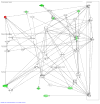Altered global gene expression in first trimester placentas of women destined to develop preeclampsia
- PMID: 19027158
- PMCID: PMC2667803
- DOI: 10.1016/j.placenta.2008.09.015
Altered global gene expression in first trimester placentas of women destined to develop preeclampsia
Abstract
Background: Preeclampsia is a pregnancy-specific disorder that remains a leading cause of maternal, fetal and neonatal morbidity and mortality, and is associated with risk for future cardiovascular disease. There are no reliable predictors, specific preventative measures or treatments other than delivery. A widely held view is that the antecedents of preeclampsia lie with impaired placentation in early pregnancy. Accordingly, we hypothesized dysregulation of global gene expression in first trimester placentas of women who later manifested preeclampsia.
Methods: Surplus chorionic villus sampling (CVS) tissues were collected at 10-12 weeks gestation in 160 patients with singleton fetuses. Four patients developed preeclampsia, and their banked CVS specimens were matched to 8 control samples from patients with unaffected pregnancies. Affymetrix HG-U133 Plus 2.0 GeneChips were utilized for microarray analysis. Naïve Bayes prediction modeling and pathway analysis were conducted. qRT-PCR examined three of the dysregulated genes.
Results: Thirty-six differentially expressed genes were identified in the preeclampsia placentas. qRT-PCR verified the microarray analysis. Thirty-one genes were down-regulated. Many were related to inflammation/immunoregulation and cell motility. Decidual gene dysregulation was prominent. No evidence was found for alterations in hypoxia and oxidative stress regulated genes.
Conclusions: To our knowledge, this is the first study to show dysregulation of gene expression in the early placentas of women approximately 6 months before developing preeclampsia, thereby reinforcing a placental origin of the disorder. We hypothesize that placentation in preeclampsia is compromised in the first trimester by maternal and fetal immune dysregulation, abnormal decidualization, or both, thereby impairing trophoblast invasion. Several of the genes provide potential targets for the development of clinical biomarkers in maternal blood during the first trimester. Supplementary materials are available for this article via the publisher's online edition.
Figures


References
-
- Ilekis J, Reddy UM, Roberts JM. Preeclampsia--a pressing problem: an executive summary of a National Institute of Child Health and Human Development workshop. Reprod Sci. 2007;14(6):508–23. - PubMed
-
- American College of Obstetricians and Gynecologists, Committee on Practice Bulletins--Obstetrics. ACOG practice bulletin. Diagnosis and management of preeclampsia and eclampsia. Obstet Gynecol. 2002;99(1):159–67. - PubMed
-
- Christiansen L, Collins KA. Pregnancy-associated deaths: a 15-year retrospective study and overall review of maternal pathophysiology. Am J Forensic Med Pathol. 2006;27(1):11–9. - PubMed
-
- Stella C, Sibai BM. Preeclampsia: Diagnosis and management of the atypical presentation. J Matern Fetal Neonatal Med. 2006;19(7):381–6. - PubMed
-
- Roberts J, Pearson G, Cutler J, Lindheimer M NHLBI Working Group. Summary of the NHLBI Working Group on research on hypertension during pregnancy. Hypertension. 2003;41(3):437–45. - PubMed
Publication types
MeSH terms
Substances
Grants and funding
LinkOut - more resources
Full Text Sources
Other Literature Sources
Molecular Biology Databases

